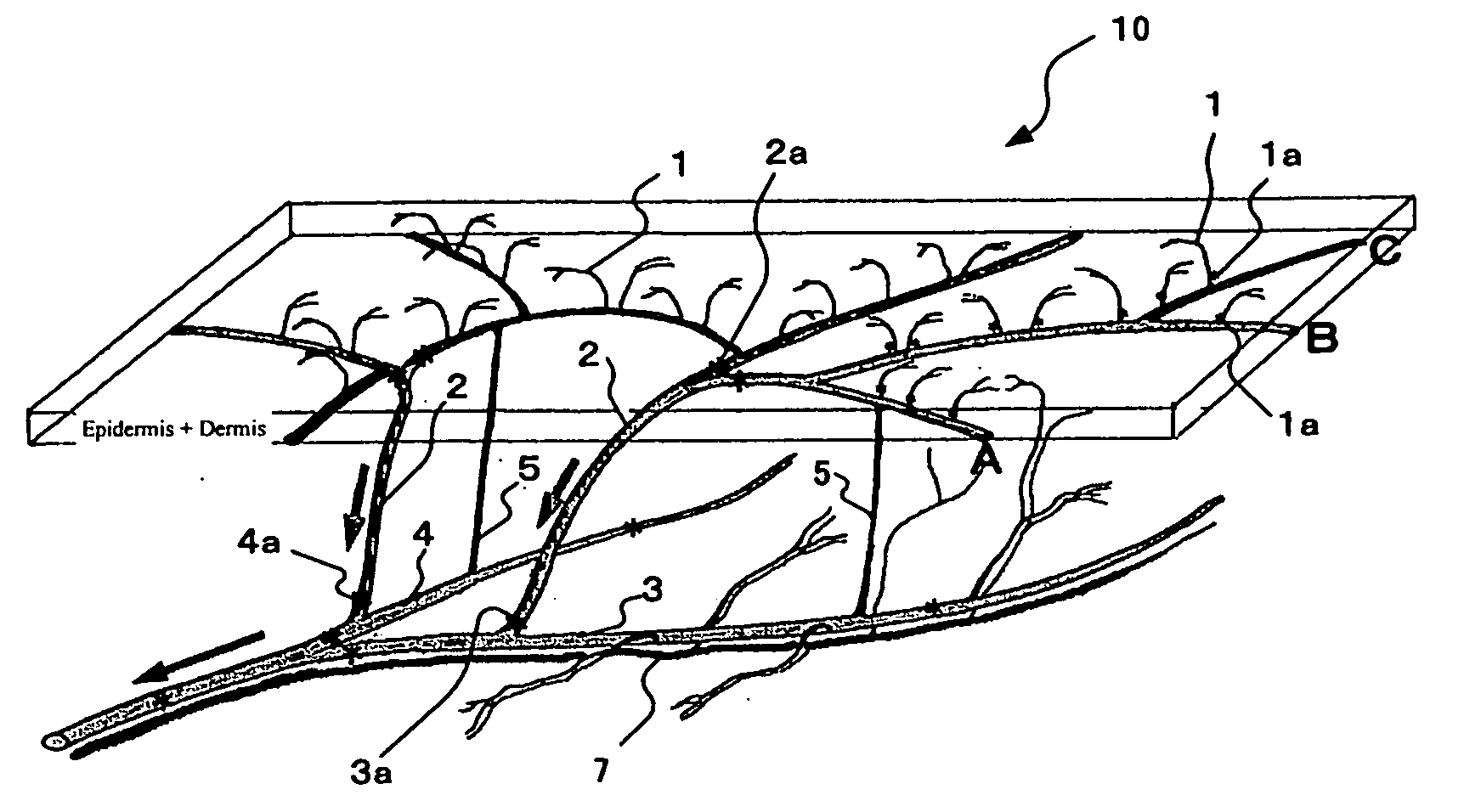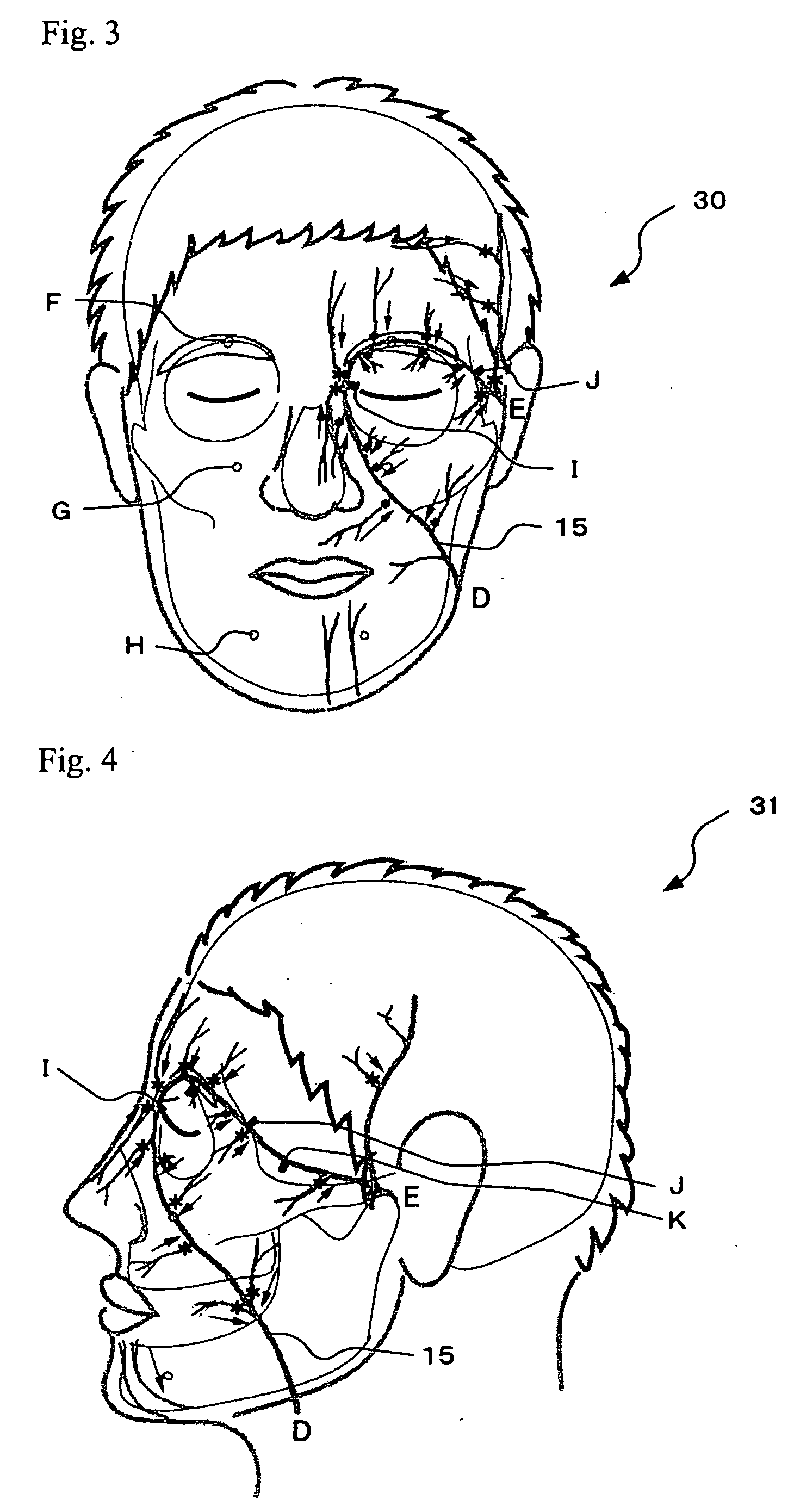Indicator, method of teaching massage operation and method of massage operation
a massage treatment and indicator technology, applied in the field of indicators, can solve the problems of significant differences in the effect, inability to improve blood flow, and ineffective treatment, and achieve the effect of reducing variation in technique and high effective massage treatmen
- Summary
- Abstract
- Description
- Claims
- Application Information
AI Technical Summary
Benefits of technology
Problems solved by technology
Method used
Image
Examples
embodiment 1
[0051]FIG. 1 is a first illustration 10 of Embodiment 1. It shows cutaneous veins in the part from the superficial part of the skin to the deep subcutaneous region, and valves in the veins. In this Embodiment 1, the first illustration 10 shows a vein (accompanied vein 3) accompanied by an artery 7 and a vein (unaccompanied vein 4) not accompanied by an artery. It also shows that most of the unaccompanied veins 4 form a venous plexus (the part including vessels A, B and C of FIG. 1) of comparatively large diameter veins, immediately below the dermis (or in the deep dermis). It also shows the presence of valves 1a (marked with asterisks in the Fig.)—which prevent reverse flow (in a distal direction) of blood from the region of the venous plexus immediately below the dermis (or in the deep dermis)—at the bases of thin vessels 1 ascending from the venous plexus located immediately below the dermis (or in the deep dermis) towards the superficial part of the skin.
[0052] On the other hand...
embodiment 2
[0055]FIG. 2 shows the 2nd illustration, as a second embodiment of the invention, and is an enlarged view of the anatomical characteristics of the skin, including the position and state of the epidermis, dermis and veins in the region immediately below the dermis, and the valves in these veins shown in the illustration 10 of FIG. 1. In this Embodiment 2, an illustration 20 of FIG. 2 shows a number of thin vessels 1 ascending towards the epidermis from the vessels (A, B and C) of the venous plexus immediately below the dermis (or in the deep dermal layer), and branching and spreading immediately below the epidermis. It also shows that thinner vessels 11 arising from a number of these thin vessels 1 form a plexus immediately below the epidermis, and even thinner vessels 12 form a venous plexus towards the epidermal papillae. In other words, it shows that the unaccompanied veins, which do not run side-by-side with arteries, are immediately below the dermis (or in the deep dermal layer)...
embodiment 3
[0057]FIGS. 3 and 4 are of 3rd illustrations of Embodiment 3, which show the position and state of cutaneous veins and the valves in these veins, on an external view of a face, as an example of the whole or a part of the human body. This Embodiment 3 includes an illustration 30 (a front view of the face) and an illustration 31 (a side view of the face) as 3rd illustrations. These 3rd illustrations 30 and 31 are useful because they can be used, along with the 1st illustration 10 and the 2nd illustration 20, as a basis for explaining a method of massage treatment of the face.
[0058] The 3rd illustrations 30 and 31 will be explained below in greater detail.
[0059] The 3rd illustration 30 (a front view of the face) and the 3rd illustration 31 (a side view of the face) display a roughly U-shaped vein 15 running from a point D on the neck to a point E at the root of the earlobe, looping around the orbit. This vein 15 that is roughly in the shape of an inverted U (referred to as “roughly U...
PUM
 Login to View More
Login to View More Abstract
Description
Claims
Application Information
 Login to View More
Login to View More - R&D
- Intellectual Property
- Life Sciences
- Materials
- Tech Scout
- Unparalleled Data Quality
- Higher Quality Content
- 60% Fewer Hallucinations
Browse by: Latest US Patents, China's latest patents, Technical Efficacy Thesaurus, Application Domain, Technology Topic, Popular Technical Reports.
© 2025 PatSnap. All rights reserved.Legal|Privacy policy|Modern Slavery Act Transparency Statement|Sitemap|About US| Contact US: help@patsnap.com



